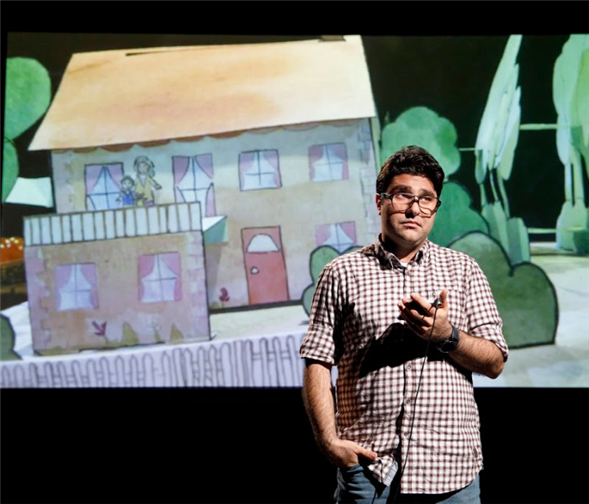Translate Page

The singular structure of Nassim Soleimanpour's new play
---
At every performance of Barrow Street Theatricals' Nassim by Nassim Soleimanpour, a new guest star performs the script unrehearsed, embarking on a journey into the unknown guided only by instinct and instructions from the author. For both the actor and the audience, surprise is key, so we're forbidden from revealing too much about this one-act that explores the bonds of language, culture and friendship.
If this setup sounds familiar, you're probably recalling Soleimanpour's last Off-Broadway show White Rabbit, Red Rabbit, which was also performed cold each night by a succession of well-known actors. The Iranian dramatist originally devised this unusual production approach out of necessity since he was barred from leaving his homeland due to refusing to participate in mandatory military service. But he figured even if he couldn't travel, his work could, and since its 2010 debut, White Rabbit, Red Rabbit has gone on to become an international phenomenon, performed in more than 25 languages worldwide, often by big-name stars. (The roster for the 2016 New York run included Nathan Lane, Whoopi Goldberg, Wayne Brady, Kyra Sedgwick, George Takei and Alan Cumming.) "I realized it was not just a gimmick," says Soleimanpour. "There is something more in this structure -- it feels like life. It's fun, it's spontaneous, and I'd say even deep and beautiful."
Thanks to being declared medically exempt from serving in 2013, Soleimanpour is now permitted to go wherever he wants, and he's currently in New York City appearing in his namesake play. Although he doesn't say any lines, he has the power to editorialize at will. As the actor reads from the script, which is also projected on a screen so the audience can follow along, Soleimanpour leans in and adds commentary when he sees fit. "I am two different people: the playwright who wrote the play, and the playwright on stage," he explains. "Nothing changes with the printed script, but I'm still a man with a Sharpie and I react as a human being. I think I'm like the navigator -- the actor is driving and I'm there to help."
{Image1}
It's illuminating for theatregoers to see Soleimanpour's text as well as hear it, as he's very particular about how his words appear on the page. "I think most playwrights basically imagine a version of what can happen and then put it down on paper as a map for everyone," he says. "But when I watch a play or a movie, I see papers. I keep thinking, does that go to the next page? Is that on the next line? When I am writing I keep asking, why should this play be 40 pages or in font size 14? Why don't we use colors in plays? I want to write in blue, yellow and red, I want to put my fingerprints on the papers."
The emotional core of Nassim is a touching tale involving the playwright's mother -- or his "mumun," the one Farsi word audiences will likely remember after the seeing the play. "She is present in the story and present in other ways as well, which is what makes this very unique to me," says Soleimanpour about how personal this play is, as opposed to White Rabbit, Red Rabbit, which was an allegory about the dangers of governmental power and societal obedience. "This show is a small thank-you gift to her."
Since Nassim is mostly just one person relaying a story, its construction seems simple, but that's deceptive. "I'm really obsessed with form, and so that's how it always starts for me," Soleimanpour says. Because of the unknown variable of a new star every night, the playwright tested out a plethora of scenarios over three and a half years of development to ensure that -- as long as the actor plays along -- the piece won't fall apart.
"It's algorithms," he explains, noting that he was an engineering student before he took up theatre. "You have to consider, what if… then this; if not… then that. Like any game, you have 'go to' or 'go back.' It's like I'm designing a car. My job is to guarantee your safety. You get a good driver and, of course, it takes it to the next level. But will it crash? I promise you not!"
Apparently a lot of artists are excited to hop on the Nassim ride -- upcoming guest stars include Tony-nominated playwright Craig Lucas, two-time Tony nominee Brad Oscar and Annie Parisse from Law & Order, to name a handful. And at every turn, Soleimanpour will be there to escort them.
"We have never had any bad instances with the actors," the playwright says, and he insists the show is foolproof. "Even if someone goes to the extreme that we get a random audience member to perform the show, I'm totally on board. I think that will prove my point."
To read about a student's experience at Nassim, check out this post on TDF's sister site SEEN.
---
TDF MEMBERS: At press time, discount tickets were available for Nassim. Go here to browse our current offers.
Gerard Raymond is an arts journalist based in New York City.
Nassim Soleimanpour in Nassim. Photos by Joan Marcus.